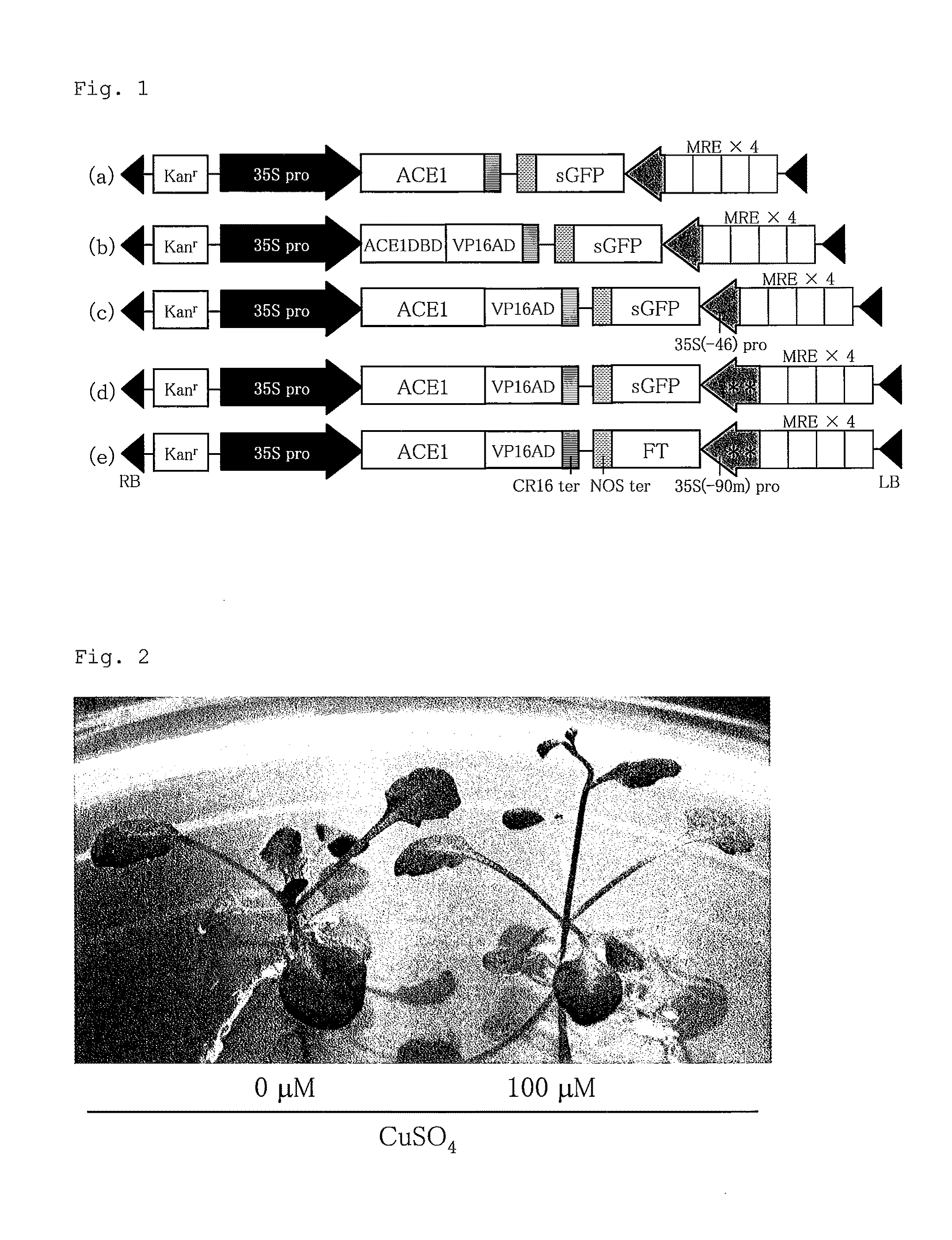Method for controlling flowering time of plant
a technology of flowering time and plant, applied in the field of method for controlling the flowering time of plants, can solve the problems of imposing a huge obstacle to improving productivity, significant toxic effects, and raising cost problems, and achieves the effects of preventing gene leakage, and reducing the risk of diseas
- Summary
- Abstract
- Description
- Claims
- Application Information
AI Technical Summary
Benefits of technology
Problems solved by technology
Method used
Image
Examples
example 1
Construction of an Introduction Vector
(1) Construction of Transcription Factor Gene Expression Cassettes
[0123]A genomic DNA was extracted from budding yeast (Saccharomyces cerevisiae strain AH22) cultured with shaking at 30° C. in a YPD medium (1% yeast extract, 2% polypeptone, 2% glucose) for 2 days by using a genome DNA extraction kit “Gen-torukun” (Takara Bio, Inc.). By using the extracted genome DNA as a template, an ACE1 transcription factor gene was amplified by PCR using two kinds of specific primers (ACE1-1F, ACE1-1RC). The amplified ACE1 transcription factor gene was cloned into pBI221 (Clontech) by replacing a GUS gene of pBI221 by the amplified ACE1 transcription factor gene to prepare p35S-ACE1-NOS. Next, a NOS terminator contained in the p35S-ACE1-NOS was replaced by a CR16 terminator (U.S. Pat. No. 7,202,083) to prepare p35S-ACE1-CR.
[0124]Seeds of recombinant Arabidopsis thaliana (No. N70016), which had been purchased from NASC (Nottingham Arabidopsis Stock Centre), w...
example 2
Analysis of GFP Accumulation Amount in Recombinant Tobacco Cultured Cells
[0137](1) Preparation and Selection of Recombinant Tobacco Cultured Cells
[0138]Each of vectors (a), (b), (c) and (d) produced in Example 1 was introduced into tobacco cultured cells (BY-2) by using gold particles of 1.0 μm in diameter coated with each of these vectors according to a particle gun method (Morikawa Hiromichi et al, 1992, Plant Cell Engineering, Vol. 4 No. 1 p. 47-52, Shujunsha Co., Ltd.). The DNA amount per 1.0 mg of gold particles was adjusted to 0.1 μg. On the 3rd to 5th days after gene introduction operation, the tobacco cell suspension cultures subjected to gene introduction were spread on a modified MS agar medium (MS inorganic salts, 3% sucrose, 1 μM 2,4-D, 1 mg / L thiamin HCl, 100 mg / L myo-inositol, 200 mg / L KH2PO4, 0.8% agar) containing 30 mg / L of kanamycin. After culturing for one month, cell mass exhibiting resistance to 30 mg / L kanamycin was selected and the selected cell masses were ag...
example 3
Flowering Induction in Recombinant Arabidopsis Thaliana
[0146](1) Preparation and Selection of Recombinant Arabidopsis Thaliana
[0147]The vector (e) prepared in Example 1 was introduced into Agrobacterium (Agrobacterium tumefaciens strain C58C1). The resulting Agrobacterium was cultured in a LB agar medium (0.5% yeast extract, 1.0% bactotrypton, 0.5% saline, 1% agar) containing 50 mg / L kanamycin, 100 mg / L ampicillin, and 100 mg / L rifampicin, and a drug-resistant colony was selected to obtain recombinant Agrobacterium. Arabidopsis (Arabidopsis thaliana ecotype Columbia) was infected by the obtained recombinant Agrobacterium according to the method described in Model Plant Laboratory Manual (edited by Iwabuchi Masaki et al, 2000, Springer-Verlag Tokyo Co., Ltd., ISBN 4-431-70881-2 C3045) to introduce genes. After T1 seeds collected from the Arabidopsis subjected to gene introduction, the seeds were plated and grown on a modified MS agar medium (MS inorganic salts, B5 vitamin, 1% sucr...
PUM
| Property | Measurement | Unit |
|---|---|---|
| diameter | aaaaa | aaaaa |
| flowering time | aaaaa | aaaaa |
| temperature | aaaaa | aaaaa |
Abstract
Description
Claims
Application Information
 Login to View More
Login to View More - R&D
- Intellectual Property
- Life Sciences
- Materials
- Tech Scout
- Unparalleled Data Quality
- Higher Quality Content
- 60% Fewer Hallucinations
Browse by: Latest US Patents, China's latest patents, Technical Efficacy Thesaurus, Application Domain, Technology Topic, Popular Technical Reports.
© 2025 PatSnap. All rights reserved.Legal|Privacy policy|Modern Slavery Act Transparency Statement|Sitemap|About US| Contact US: help@patsnap.com

